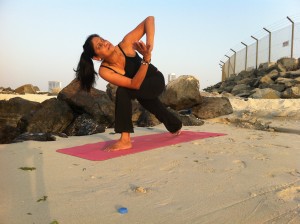Why Twist?
What if we couldn’t twist? Imagine that. We wouldn’t be able to swing a golf club or lean diagonally across a table or reach for a bag in the back seat of a car…Take walking for example, right foot forward left hand forward & vice versa. This creates moderately a whole body twist and it is actually calming to our nervous system, without which there would be slight imbalance in the body.
Every balanced & well-rounded program of a Hatha Yoga class encompasses a couple of twists somewhere in the sequence, maybe seated, standing, inverted or supine. Welcomed both at the beginning and at end of the class by all, twists have a fine way of bringing even-ness to the body especially if you’ve skipped or favored one side. They complement forward and backbends by exercising the muscles in many complex ways.
The popular description of a twist is given by BKS Iyengar as a “squeeze-and-soak” action. The organs are compressed during a twist, pushing out toxic filled blood. Once the twist is released, fresh oxygenated blood flows in. Hence, physiologically, twists stimulate circulation and have a cleansing effect on the bodily organs. Looking structurally, twists  help keep the spine elastic by retaining its mobility and stability. The range of motion of our spinal column range of motion can be affected and limited not only by arthritis or surgery but also gradual shortening of soft tissues due to a sedentary lifestyle. This diminished the mobility of the nearby joints. Yoga twists help keep the normal length of the soft tissues around the spine, rib cage and hips, hence maintaining the normal range of motion in the spine. Internally, the abdominal organs receive a good squeeze and a massage, allowing for special stimulation especially to the large intestine. This relieves constipation and other digestive disorders.
help keep the spine elastic by retaining its mobility and stability. The range of motion of our spinal column range of motion can be affected and limited not only by arthritis or surgery but also gradual shortening of soft tissues due to a sedentary lifestyle. This diminished the mobility of the nearby joints. Yoga twists help keep the normal length of the soft tissues around the spine, rib cage and hips, hence maintaining the normal range of motion in the spine. Internally, the abdominal organs receive a good squeeze and a massage, allowing for special stimulation especially to the large intestine. This relieves constipation and other digestive disorders.
In a seated twist, the common tendency is to move too quickly which results in the neck or the cervical doing most of the twisting. The twist should start form the navel upwards, run along each vertebra, as if one were climbing a spiral staircase, followed up to the top, neck, gaze is the last to move to the corner of the eye socket-parsva drishti. There is complete awareness in the body as the breath guides one into the twist. Inhalation aids the expansion, while exhalation takes you deeper, only to the level between comfort and strain. Hence awareness of the breath in the movement is another complementary benefit that one derives as we move into a twist.
I’ve highlighted one of our all-time favorite being the simple supine twist. Lie on your back, bend both knees close to chest, hands outstretched shoulder level. There is some muscular effort required to keep the knees close to the chest, which incidentally makes this twist a partial forward bend as well as. Lower both knees to the side on the exhalation. This pose removes all tensions from the hips, lumbar area and the sacroiliac region. The head is sometimes best kept in a neutral position to observe the interesting effects in the rest of the body.
As Ramadan sets in, fasting and Yoga complement each other perfectly. While fasting can offer a quick flush of built up toxins, it can also cause fatigue and sometimes even irritability, here’s yoga to the rescue. The combined movements of gentle stretching and twisting along with deep breathing practices; aids to smoothen the process of detox entirely. If twists help better circulation and better circulation equals better health, then why not twist…
Thanks to ZenYoga for highlighting the same in their July newsletter. Click here to check it out and also read more importance of fibre in our diet by Victoria Tipper.